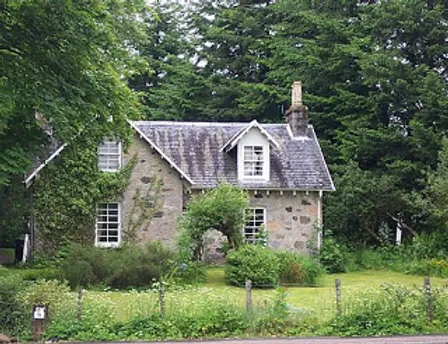If you spy a quaint cottage while on your travels in the countryside, you may have spotted what could originally have been a tied cottage. Yes, cottages, those quaint symbols of British rural life that now have a market value of hundreds of thousands, were likely to have housed the poor working families of yesteryear.
So what makes a cottage tied?

What is Meant by a Tied Cottage?
Cottages are small dwellings that are often found in rural locations. They are likely to have two or three bedrooms and be simple in design.
Older cottages may be thatched. And despite their attraction to modern house buyers, cottages of the past were often quickly constructed using the cheapest of methods. Why? That comes down to the purpose of the cottage being ‘tied’.
A tied cottage is a cottage that was constructed by a landowner to provide housing for agricultural workers. And in fact, the concept of the tied cottage is still very much connected to agriculture.
Tied cottages would have been built for rural workers in order to ‘tie’ them to their place of work – hence the name. And the landowner was rarely interested in wasting too much money on their employees by giving them state-of-the-art homes.
Tied cottages were therefore cheap and simple.
Historically, a tied cottage would have been provided rent-free by the landowner or for a peppercorn rent. This would have made staying at one place of work much more attractive for workers.
Especially those that may have travelled around the countryside to do different jobs at different times of the year.

Are Tied Cottages a thing of the Past?
Tied cottages are still around. And they are still associated with accommodation for agricultural workers and some other industries.
And it’s easy to see why this type of accommodation might seem an attractive option today with higher wages and improved worker’s rights.
But nowadays, a worker’s tied accommodation is just as likely to be a caravan as a cottage and is rarely ‘free’. And, rather than a tied cottage a modern worker might get tied tenancy which means their accommodation can be highly variable.
What is a Tied Tenancy?
Unlike a tied cottage, modern workers in agriculture and some other industries may be offered a ‘tied tenancy’ as part of their work contract.
And while it may seem attractive to have reduced rates on accommodation, it may ultimately cost more than private renting and be a less stable form of housing in the long term.
Simply put, tied tenancy is a tenancy agreement for accommodation that is provided by the employer for the duration of your employment. Some employers may seem to provide housing that comes ‘free’ as part of your working contract.
Be careful here. The housing is unlikely to be free as the cost will probably be taken from your wages before you get paid.
But whether your employer requires you to pay rent directly to them or not, a tied tenancy is almost always linked to your job.
There are a few types of tied tenancy types. Two of which are ‘service occupier’ and ‘service tenant’. But for both types of tenancy, if you leave that employment or are unable to continue working, you will be required to give up your property or risk eviction.
It’s always best to read the small print on any paperwork, but with tied tenancies, it’s extra important. And it’s best to know as much as possible about your agreement before you sign any contracts.
If you can afford it, get a property lawyer to cast an eye over the tenancy agreement before you sign. Their experienced eye will spot any potential loopholes that could be missed.
As tied accommodation is still linked closely to farming, it may not come as a surprise that agricultural workers have more rights under tied tenancy laws than other tied tenants from other industries. Although, this doesn’t make it fair.
But what exactly are those rights?
Let’s look into some of the basics of tied cottages or tied tenancy rights in more detail.

What Are Tied Cottage Tenant Rights?
Tied cottage tenant rights or, indeed, any tied tenancy rights are a bit of a minefield.
So if you are offered a tied cottage tenancy as part of your agricultural work package – read the small print and find out about your Agricultural worker’s rights on the gov.uk website.
If you are thinking about taking up a tied cottage offer, we’d recommend getting legal advice first. Because all tenancies are different and agricultural workers’ tenancy rights vary.
But below you will find some general information to give you an idea of some things to be aware of regarding your tied cottage tenancy rights.
You may receive a written notice at the start of your tenancy which gives you a shorthold tenancy. This is for short-term or temporary farm workers.
But even if this is the case, make sure you carefully read through your tenancy agreement from your employer. This will explain the rights the employer grants you with regard to your tenancy.
These include things like:
- Property maintenance
- Safety measures
- Duration of the lease
- Notice period
- Rental costs
- Increase/Review of rental costs – dates/times/notice period for rent review
- Deposit amounts and protection of the deposit
- Terms of the tenancy with regards to employment
- The name of the owner of the rental property and the account you’re paying into or how the rental costs will be deducted and how this will show up on your wage slip.
If you have been given no tenancy agreement you risk being unprotected by law. So, ask for a tenancy agreement if you are a short-term worker.
If you are a longer-term farm worker, you may have rights to your tied cottage or accommodation if you have been working in agriculture for 91 weeks out of 104. This includes holiday and sick leave.
You also need to have worked 35 hours a week or more and the accommodation you are provided with is owned or arranged by the farmer.
The tenant also needs to meet the following criteria:
- Be a serving farmer worker (or a farm manager)
- Be a retired farm worker
- Have been a farm worker but had to give up farm work
- Have taken up other employment but were formerly a farm worker
- Are the widow, widower, or were living with the farm worker when they died
- Have worked for the farm that provided the accommodation
If you fulfil this criterion, your tenancy or accommodation may automatically be classed as ‘assured agricultural occupancy’.
This gives you more protection over your continued right to stay in your tied cottage or property.
Whatever type of tied accommodation you are provided with, it’s best to become as informed as possible about Agricultural workers’ rights. This will help ally any fears surrounding your living arrangements and make your working life more stable and enjoyable.
What Types of Cottages Can be Tied?
Like most things, opinions vary as to what constitutes a cottage. Cottages of the past vary greatly from what might be considered a cottage for a new build.
You may recognise very old cottages in rural areas by how small they are. These older types can be thatched too – just like the nostalgic images you can find about the UK’s rural heritage.
These types of cottages are often originally linked to agriculture in rural areas.
They may seem idyllic but they have their problems too. Upkeep is the biggest probably with older cottages.
Re-thatching, heating costs and general upkeep are things to consider. An employer or landlord may be responsible for this, but they may expect the tenant to perform general maintenance, so it’s good to check this.
But quaint thatched cottages are not the only types. You might find more modern cottages in terraces or semi-detached properties that were built during periods of agricultural growth in certain areas.
If fact, whole villages were created by large-scale landowners for their tied workers.
Sometimes, tied cottages would extend to service personnel like village policemen. And during the industrial revolution and times industrial growth tied cottages extended to other trades.
For example, early coal miners and their families were housed in tied cottages.
The mechanisation of modern farming has changed the agricultural landscape almost entirely. So a modern tied cottage may not be on or even near a farmer’s property.
Some of these modern tied cottages can also vary greatly in their size and aesthetics.
One thing has not changed though. Farm owners are just as likely to want to save money on creating tied cottages as they were in the past.
So if you’re considering taking up tied accommodation, have a viewing of the cottage first. You don’t want a nasty surprise.
Having said that, some tied cottages offer security and are financially beneficial to the tenant if the employer is ethical and considerate – and many are.



